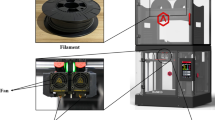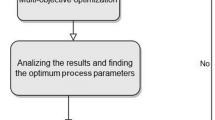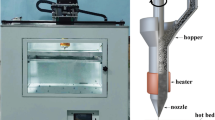Abstract
3D printing offers great potential for developing complex flexure mechanisms. Recently, thickness-correction factors (TCFs) were introduced to correct the thickness and stiffness deviations of powder-based metal 3D printed flexure hinges during design and analysis. However, the reasons for the different TCFs obtained in each study are not clear, resulting in a limited value of these TCFs for future design and fabrication. Herein, the influence of the porous layer of 3D printed flexure hinges on the hinge thickness is investigated. Samples of parallelogram flexure mechanisms (PFMs) were 3D printed using selective laser melting (SLM) and 316L stainless steel powder. A 3D manufacturing error analysis was completed for each PFM sample via 3D scanning, surface roughness measurement and morphological observation. The thickness of the porous layer of the flexure hinge was independent of the designed hinge thickness and remained close to the average powder particle diameter. The effective hinge thickness could be estimated by subtracting twice the value of the porous layer thickness from the designed value. Guidelines based on finite element analysis and stiffness experiments are proposed. The limitations of the presented method for evaluating the effective hinge thickness of flexure hinges 3D printed via SLM are also discussed.











Similar content being viewed by others
References
Cabanettes, F., Joubert, A., Chardon, G., Dumas, V., Rech, J., Grosjean, C., et al. (2018). Topography of as built surfaces generated in metal additive manufacturing: A multi scale analysis from form to roughness. Precision Engineering, 52(January), 249–265. https://doi.org/10.1016/j.precisioneng.2018.01.002.
Campana, G., & Mele, M. (2020). An application to Stereolithography of a feature recognition algorithm for manufacturability evaluation. Journal of Intelligent Manufacturing, 31(1), 199–214. https://doi.org/10.1007/s10845-018-1441-8.
Chen, W., Zhang, X., & Fatikow, S. (2016). A novel microgripper hybrid driven by a piezoelectric stack actuator and piezoelectric cantilever actuators. Review of Scientific Instruments, 87(11), 115003. https://doi.org/10.1063/1.4967218.
Cho, S. B., Ro, S. K., Kim, B. S., Lee, S. C., & Park, J. K. (2020). The development of a micro-pattern manufacturing method using rotating active tools with compensation of estimated errors and an LMS algorithm. Journal of Intelligent Manufacturing. https://doi.org/10.1007/s10845-020-01558-1.
Clark, L., Shirinzadeh, B., Bhagat, U., Smith, J., & Zhong, Y. (2015). Development and control of a two DOF linear-angular precision positioning stage. Mechatronics, 32, 34–43. https://doi.org/10.1016/j.mechatronics.2015.10.001.
Clark, L., Shirinzadeh, B., Tian, Y., & Zhong, Y. (2014). The bounds on tracking performance utilising a laser-based linear and angular sensing and measurement methodology for micro/nano manipulation. Measurement Science & Technology, 25(12), 125005. https://doi.org/10.1088/0957-0233/25/12/125005.
Clark, L., Shirinzadeh, B., Zhong, Y., Tian, Y., & Zhang, D. (2016). Design and analysis of a compact flexure-based precision pure rotation stage without actuator redundancy. Mechanism and Machine Theory, 105(August), 129–144. https://doi.org/10.1016/j.mechmachtheory.2016.06.017.
Coemert, S., Traeger, M. F., Graf, E. C., & Lueth, T. C. (2017). Suitability evaluation of various manufacturing technologies for the development of surgical snake-like manipulators from metals based on flexure hinges. Procedia CIRP, 65, 1–6. https://doi.org/10.1016/j.procir.2017.03.108.
Dilberoglu, U. M., Gharehpapagh, B., Yaman, U., & Dolen, M. (2017). The role of additive manufacturing in the era of Industry 4.0. Procedia Manufacturing, 11, 545–554. https://doi.org/10.1016/j.promfg.2017.07.148.
Fiaz, H. S., Settle, C. R., & Hoshino, K. (2016). Metal additive manufacturing for microelectromechanical systems: Titanium alloy (Ti–6Al–4 V)-based nanopositioning flexure fabricated by electron beam melting. Sensors and Actuators, A: Physical, 249, 284–293. https://doi.org/10.1016/j.sna.2016.08.029.
Gaynor, A. T., Meisel, N. A., Williams, C. B., & Guest, J. K. (2014). Multiple-material topology optimization of compliant mechanisms created via PolyJet three-dimensional printing. Journal of Manufacturing Science and Engineering, 136(6), 061015. https://doi.org/10.1115/1.4028439.
Hao, G. (2017). Design and analysis of symmetric and compact 2R1T (in-plane 3-DOC) flexure parallel mechanisms. Mechanical Sciences, 8(1), 1–9. https://doi.org/10.5194/ms-8-1-2017.
Hayes, G. R., Frecker, M. I., & Adair, J. H. (2011). Fabrication of compliant mechanisms on the mesoscale. Mechanical Sciences, 2, 129–137. https://doi.org/10.5194/ms-2-129-2011.
Lee, C., & Tarbutton, J. A. (2015). Compliance and control characteristics of an additive manufactured-flexure stage. Review of Scientific Instruments, 86(4), 1–9. https://doi.org/10.1063/1.4918982.
Li, Y., & Xu, Q. (2012). Design and robust repetitive control of a new parallel-kinematic XY piezostage for micro/nanomanipulation. IEEE/ASME Transactions on Mechatronics, 17(6), 1120–1132. https://doi.org/10.1109/TMECH.2011.2160074.
Lobontiu, N. (2002). Compliant mechanisms: design of flexure hinges. Boca Raton: CRC Press.
Merriam, E. G., Jones, J. E., & Howell, L. L. (2014). Design of 3D-printed titanium compliant mechanisms. In Proceedings of the 42nd aerospace mechanisms symposium (pp. 169–174).
Merriam, E. G., Jones, J. E., Magleby, S. P., & Howell, L. L. (2013). Monolithic 2 DOF fully compliant space pointing mechanism. Mechanical Sciences, 4(2), 381–390. https://doi.org/10.5194/ms-4-381-2013.
Merriam, E. G., Tolman, K. A., & Howell, L. L. (2016). Integration of advanced stiffness-reduction techniques demonstrated in a 3D-printable joint. Mechanism and Machine Theory, 105, 260–271. https://doi.org/10.1016/j.mechmachtheory.2016.07.009.
Mutlu, R., Alici, G., in het Panhuis, M., & Spinks, G. M. (2016). 3D printed flexure hinges for soft monolithic prosthetic fingers. Soft Robotics, 3(3), 120–133. https://doi.org/10.1089/soro.2016.0026.
Mycroft, W., Katzman, M., Tammas-Williams, S., Hernandez-Nava, E., Panoutsos, G., Todd, I., et al. (2020). A data-driven approach for predicting printability in metal additive manufacturing processes. Journal of Intelligent Manufacturing. https://doi.org/10.1007/s10845-020-01541-w.
Niu, X., Singh, S., Garg, A., Singh, H., Panda, B., Peng, X., et al. (2018). Review of materials used in laser-aided additive manufacturing processes to produce metallic products. Frontiers of Mechanical Engineering, In press.. https://doi.org/10.1007/s11465-019-0526-9.
Pham, M. T., Teo, T. J., Yeo, S. H., Wang, P., & Nai, M. L. S. (2017). A 3D-printed Ti–6Al–4 V 3-DOF compliant parallel mechanism for high precision manipulation. IEEE/ASME Transactions on Mechatronics, 22, 2359–2368. https://doi.org/10.1109/TMECH.2017.2726692.
Qin, Y., Shirinzadeh, B., Zhang, D., & Tian, Y. (2013). Design and kinematics modeling of a novel 3-DOF monolithic manipulator featuring improved Scott-Russell mechanisms. Journal of Mechanical Design. DOI, 10(1115/1), 4024979.
Strano, G., Hao, L., Everson, R. M., & Evans, K. E. (2013). Surface roughness analysis, modelling and prediction in selective laser melting. Journal of Materials Processing Technology, 213(4), 589–597. https://doi.org/10.1016/j.jmatprotec.2012.11.011.
Wei, H., Li, W., Liu, Y., Wang, Y., & Yang, X. (2017a). Quasi-static analysis of a compliant tripod stage with plane compliant lever mechanism. Proceedings of the Institution of Mechanical Engineers, Part C: Journal of Mechanical Engineering Science, 231(9), 1639–1650. https://doi.org/10.1177/0954406215619193.
Wei, H., Shirinzadeh, B., Li, W., Clark, L., Pinskier, J., & Wang, Y. (2017b). Development of piezo-driven compliant bridge mechanisms: general analytical equations and optimization of displacement amplification. Micromachines, 8(8), 238. https://doi.org/10.3390/mi8080238.
Wei, H., Wang, L., Niu, X., Zhang, J., Mao, Z., Simeone, A., & Zhang, Q. (2019). Study of effective hinge thickness of additive- manufactured flexure mechanisms. In 2019 IEEE international conference on manipulation, manufacturing and measurement on the nanoscale (3 M-NANO), i (pp. 307–311).
Wei, H., Wang, L., Niu, X., Zhang, J., & Simeone, A. (2018). Fabrication, experiments, and analysis of an LBM additive-manufactured flexure parallel mechanism. Micromachines, 9(11), 572. https://doi.org/10.3390/mi9110572.
Yu, J., Xie, Y., Li, Z., & Hao, G. (2015). Design and experimental testing of an improved large-range decoupled XY compliant parallel micromanipulator. Journal of Mechanisms and Robotics, 7(4), 044503. https://doi.org/10.1115/1.4030467.
Acknowledgements
This work was supported by the Scientific Research Foundation of Shantou University (No: NTF18002), National Key R&D Program of China (No: 2018YFB1701701) and Science and Technology Planning Project of Guangdong Province (No: 2017A050501061).
Author information
Authors and Affiliations
Corresponding author
Additional information
Publisher's Note
Springer Nature remains neutral with regard to jurisdictional claims in published maps and institutional affiliations.
Rights and permissions
About this article
Cite this article
Wei, H., Shirinzadeh, B., Niu, X. et al. Study of the hinge thickness deviation for a 316L parallelogram flexure mechanism fabricated via selective laser melting. J Intell Manuf 32, 1411–1420 (2021). https://doi.org/10.1007/s10845-020-01621-x
Received:
Accepted:
Published:
Issue Date:
DOI: https://doi.org/10.1007/s10845-020-01621-x




